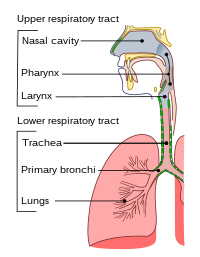
Photo from wikipedia
Introduction: Invasive fungal infections are increasingly common in the nosocomial setting. Materials and Methods: The patients were divided into two groups immunocompetent and immunocompromised that is, patients with significant neutropenia Click to show full abstract
Introduction: Invasive fungal infections are increasingly common in the nosocomial setting. Materials and Methods: The patients were divided into two groups immunocompetent and immunocompromised that is, patients with significant neutropenia <500 neutrophils/μl for longer than 10 days. microscopy, culture, identification of isolates were done and some specilised tests on serum and BAL for antigen detection were performed. Results: Majority of the patients were young adult males in this study. A higher prevalence of 26.7% was seen in immunocompromised patients. Amongst yeasts, Candida albicans was the predominant species followed by the National AIDS Control that is, Candida glabrata, Candida dubliniensis, Candida parapsilosis and Candida tropicalis in the same order. Amongst moulds, Aspergillus fumigatus was the most common species followed by Aspergillus flavus and Aspergillus niger. Mucor and Penicillium marneffei were seen in a lower prevalence. By Broth microdilution method, isolates of Candida spp. were most sensitive to caspofungin, amphotericin B, ketoconazole and fluconazole in the same order. Isolates of Aspergillus spp. were most sensitive to caspofungin, amphotericin B and itraconazole in the same order. By disc diffusion method, resistance to fluconazole was observed in 6.9% isolates of C. albicans. 50% of C. dubliniensis and 20% of C. glabrata showed resistance to fluconazole. A total mortality of 27.7% was observed during this study. This was distributed as 24.1%, 26.7%, 50%, 50%, 100% and 0% among by patients of candidiasis, aspergillosis, cryptococcosis, pneumocystosis, mucormycosis and penicilliosis. Fifteen per cent were lost to follow-up. Conclusion: Patterns of invasive fungal infections are changing in many ways. In the midst of these evolving trends, IFI of the respiratory tractcontinue to remain important causes of morbidity and mortality. Diagnostic tools can be adequately used only if the treating physician is aware of the propensity of patients to acquire a fungal infection. Thus, continuous awareness and education is crucial for successful management of patients. Judicious use of antifungal medications as prophylactic measures must be employed, particularly in the critically ill and patients of HIV.
Journal Title: Indian Journal of Medical Microbiology
Year Published: 2018
Link to full text (if available)
Share on Social Media: Sign Up to like & get
recommendations!